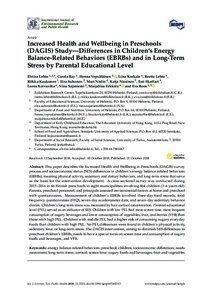Increased Health and Wellbeing in Preschools DAGIS) Study—Differences in Children’s Energy Balance-Related Behaviors (EBRBs) and in Long-Term Stress by Parental Educational Level
Lehto Elviira; Ray Carola; Vepsäläinen Henna; Korkalo Liisa; Lehto Reetta; Kaukonen Riikka; Suhonen Eira; Nislin Mari; Nissinen Kaija; Skaffari Essi; Koivusilta Leena; Sajaniemi Nina; Erkkola Maijaliisa; Roos Eva
https://urn.fi/URN:NBN:fi-fe2021042720064
Tiivistelmä
This paper describes the Increased Health and Wellbeing in Preschools (DAGIS) survey process and socioeconomic status (SES) differences in children’s energy balance-related behaviors (EBRBs), meaning physical activity, sedentary and dietary behaviors, and long-term stress that serve as the basis for the intervention development. A cross-sectional survey was conducted during 2015–2016 in 66 Finnish preschools in eight municipalities involving 864 children (3–6 years old). Parents, preschool personnel, and principals assessed environmental factors at home and preschool with questionnaires. Measurement of children’s EBRBs involved three-day food records, food frequency questionnaires (FFQ), seven-day accelerometer data, and seven-day sedentary behavior diaries. Children’s long-term stress was measured by hair cortisol concentration. Parental educational level (PEL) served as an indicator of SES. Children with low PEL had more screen time, more frequent consumption of sugary beverages and lower consumption of vegetables, fruit, and berries (VFB) than those with high PEL. Children with middle PEL had a higher risk of consuming sugary everyday foods than children with high PEL. No PEL differences were found in children’s physical activity, sedentary time, or long-term stress. The DAGIS intervention, aiming to diminish SES differences in preschool children’s EBRBs, needs to have a special focus on screen time and consumption of sugary foods and beverages, and VFB.
Kokoelmat
- Rinnakkaistallenteet [27094]
